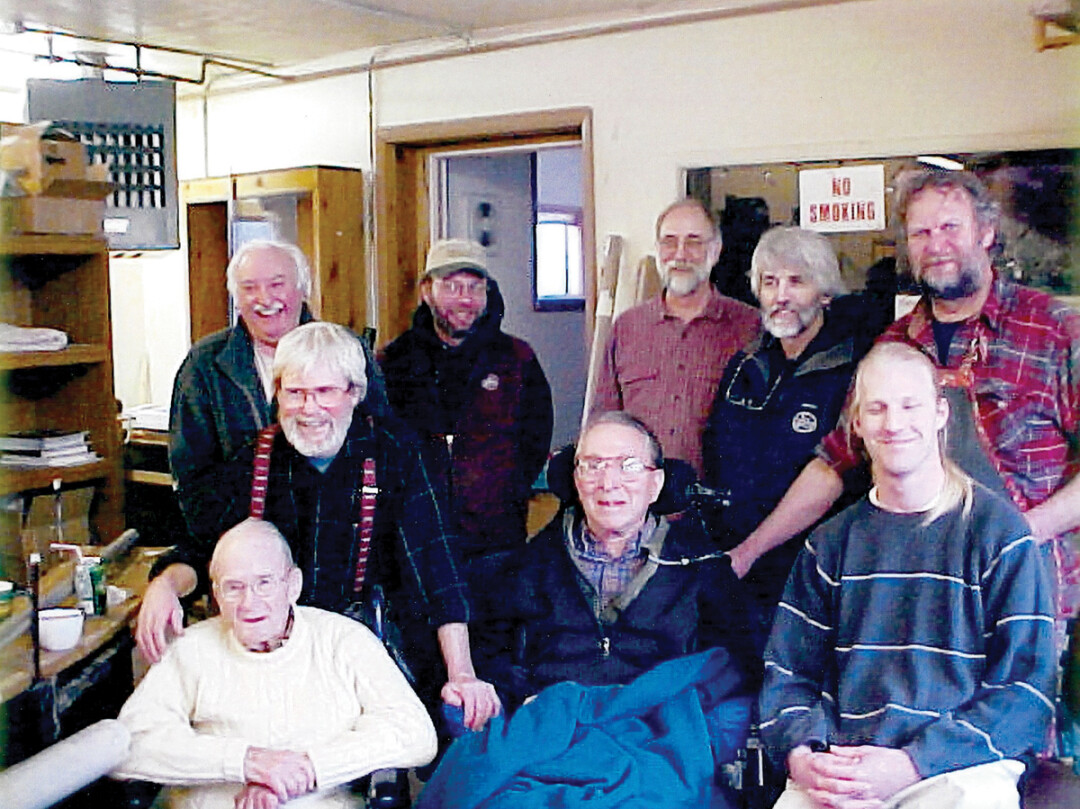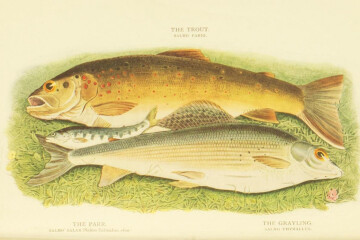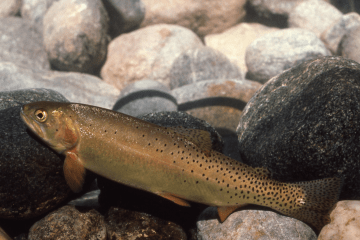Asian Grass in Montana: A Brief History of Bamboo Rods at R.L. Winston Rod Company
As many of you already know, Montana’s own, world renowned, legendary R.L. Winston Rod Company recently experienced a devastating fire at its bamboo rod-making facility in Twin Bridges, Montana. For many companies, a loss like that, especially in a business as competitive, exclusive, and niche-like as bamboo rod building, would spell the end. But not for Winston. The company has a long history of staying relevant, innovative, and in-demand by building high-quality rods for the discerning angler. And, like a phoenix from the ashes, general manager Jeff Wagner vows the bamboo department will rise again and continue the tradition of building bamboo rods for anglers the world over. 
A Brief History: Lew Stoner and Robert Winther [ Photo courtesy of R.L. Winston Rod Co.]
The company was started in 1929 by Robert Winther and Lew Stoner in San Francisco, California. The two men had a desire to build high quality fishing rods and soon developed a reputation among anglers for making tough rods that performed well. In the early 1930s, Winther sold his interest in the company to an employee and diehard fly fisherman Red Loskot. About twenty years later, Loskot sold his part of the company to Doug Merrick who, after the passing of Lew Stoner, became the sole proprietor of the business.
Winston had been very successful with its bamboo rod business and its rods had been used repeatedly to break world records in casting. But there was a new player in the game, fiberglass, and Merrick started making fly rods from this new material. The story of how fiberglass rods were invented is unique in its own right, with a Montanan legacy, and deserves a bit of an aside here.
The inventor of fiberglass rods was Dr. Arthur Howald, whose son Reed stepped on one of his bamboo rods as a child and broke it. Arthur, who was the technical director of the Libby-Owens-Ford Glass Co., decided at first to try and repair it with fiberglass, but after getting started on the repair, thought why not make a whole rod out of fiberglass? That is exactly what he did and by doing so gave birth to durable and inexpensive rods that are still used by anglers the world over. Reed still lives in Bozeman and is a retired MSU professor. If you want to hear the whole story check out the MSU Angling Oral History Project where Reed recounts this and many tales of angling around Bozeman over the past several decades.
Okay, back to Winston. While Merrick had started the fiberglass rod building at Winston, it was Tom Morgan, who purchased the company in 1973, who really brought it to life. Tom saw a market for the new fiberglass models and, as they took less time and money to create, felt it was a way for the company to remain profitable while allowing it to also continue the tradition of building high-quality bamboo rods. Tom introduced several innovative ideas into the process, which made the rods durable, more responsive, and better received by anglers who had grown up fishing bamboo.
In 1974, Glenn Brackett came on as an employee and later as a partner in the bamboo side of the business. After a couple of years, Glenn and Tom decided to move the operation from San Francisco to Twin Bridges, Montana, where it has remained ever since. A good part of the reasoning for the move was the access it provided to the clear, cold, beautiful, trout-filled, rivers of the Rocky Mountains. Tom and Glenn continued to refine the art of bamboo rod making, even selecting their own bamboo in Asia, and expanded the fiberglass and graphite efforts until 1991 when Winston was purchased by David Ondaatje. David continues to keep the bamboo division going and employes some of the best artisans in the business.
Talent Breeds Talent
One of the coolest things about Winston is the talent they attracted, developed, and often let free to form other fantastic, influential, and quality rod-making companies. Lew Stoner, part-owner and original bamboo craftsman at Winston, was very much responsible for starting this tradition. Lew built his first bamboo rod in 1894 at the age of 13 and continued making them for the remainder of his life. Until he helped form Winston in 1929, he built them in his basement and started a couple of small and short-lived companies. Lew was a craftsman and developed a loyal customer base because of his attention to detail and intolerance for imperfection in his products. Lew’s fans included the legendary Ted Trueblood and Field and Stream’s fishing editor A.J. McClane who once said his 8 ½ Stoner rod could toss a flatiron over a post office.
In 1957, Lew took on a 15-year old apprentice named Gary Howells. Gary would go on to work for Winston for the next 13 years. In 1969, Gary decided to go out on his own and started Howells Rod Company in 1970. Howells again, like his mentor, developed a loyal customer base by making high quality bamboo rods. Gary became so successful that he was able to limit his rod building to 6-8 months a year and spend the rest of the time traveling the world fishing.
To show how prized these rods still are today, 20 years after Gary closed his shop, if you wanted one for yourself you’d need to plan on spending upwards of $3,000.
Tom Morgan purchased Winston in 1973, and while focusing the company’s efforts on graphite and fiberglass, never lost sight of the important place bamboo rods hold in the both the history and current state of angling. He states on his website, www.troutrods.com/bamboo.html, Tom Morgan Troutrods - Bamboo Rods “The sweetest trout rods ever made...” Tom
“Despite the popularity of fiberglass and graphite as rod-making materials, they haven’t entirely replaced bamboo rods, many of which are still highly prized by anglers not only for their collector’s value but also for their great fishing attributes. How could this be? Perhaps the greatest reason is bamboo rods have been the foundation of our modern fly fishing heritage since the late 1800s.”
Tom sold Winston in 1991 and formed Tom Morgan Rodsmiths. Tom, with his wife Gerri, decided to start the new business because they wanted to focus on building a limited number of superior graphite and bamboo rods that were not limited by cost or materials. Basically, they wanted to build dream rods that were never meant to be mass produced because of the time, effort, and select materials required to make these unique angling works of art. Tom has won the prestigious Bellinger Award for his contributions to bamboo rod-making and also invented the Morgan Bamboo Hand Mill, which as he states, “allows a beginner rod-maker to plane a strip as perfectly as a master.”
While still at Winston, Tom hired Glenn Brackett, who later became a partner in the business. Glenn grew up in San Francisco and had fond memories of the Winston shop from his youth. He was also an avid angler who brought that perspective with him to the business. Glenn stayed with Winston until 2005 when he and co-worker Jerry Kustich went out on their own to open Sweetgrass Rods based in Twin Bridges and Butte, Montana. Glenn is a master craftsman who has over 4 decades of experience making the finest bamboo rods known to man. In addition, he is one of the most warm, kind, and generous individuals you could ever hope to meet. Glenn personally knew and learned the craft from Lew Stoner, Doug Merrick, Gary Howells, and Tom Morgan and strives to carry on the tradition of building high quality bamboo rods that capture the history, elegance, and strength of fly fishing in every cast. When River Monsters host Jeremy Wade was in Montana this past spring, it was on a Sweetgrass bamboo rod that he landed his first Montana Brown Trout.
After Glenn heard about the fire at the Winston shop, he was simply devastated at the loss of history that went up in those flames. He sent me the picture below of the last day that he, Tom, and the rest of the crew were at the old shop together. When Winston’s shop, his competitor, burned, Glenn offered the Winston crew the use of his shop in Twin Bridges until they can rebuild, instead of reveling in the loss of competition.
A Final Note
When Lew Stoner and Robert Winther created Winston in 1929 by combining their two names, they could not have guessed that they would be creating a company that would remain a cornerstone of the angling industry for nearly nine decades. As Ed Engle states in his book Splitting Cane, “Fly Fishers recognize the name Winston. Some words are just synonymous with the sport. Winston fly rods are the rods with history--the rods that have been around forever.”



